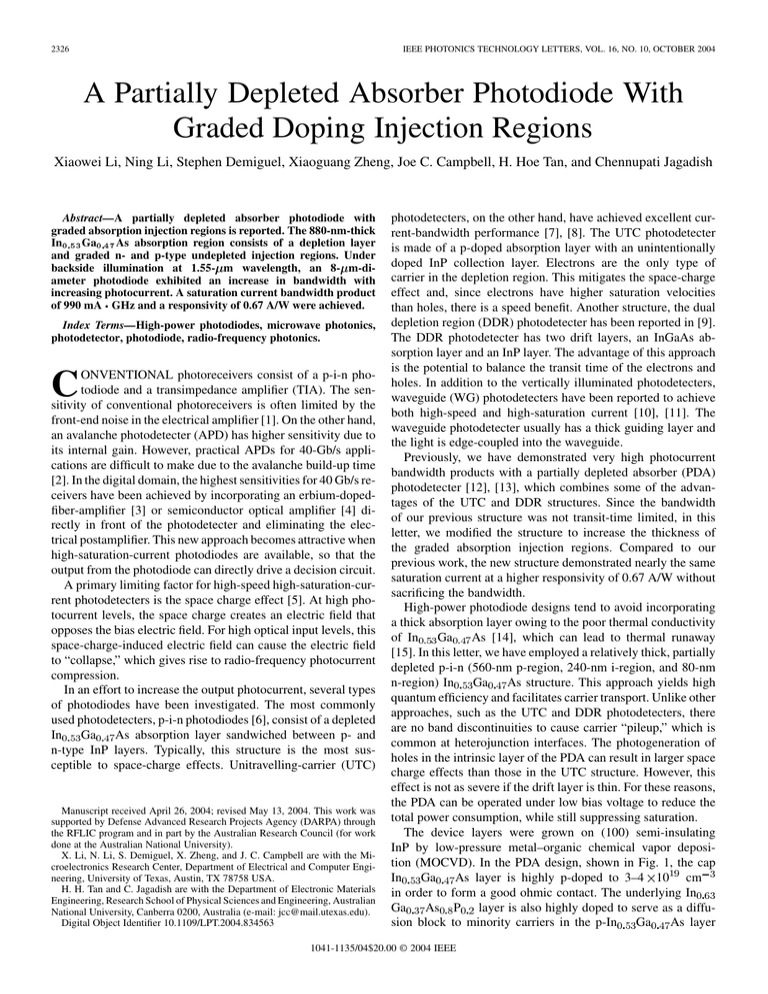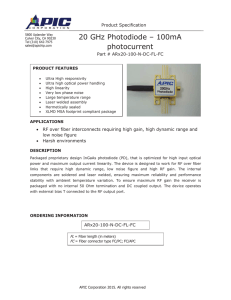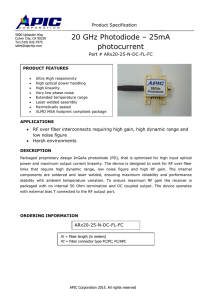A Partially Depleted Absorber Photodiode With Graded Doping
advertisement

2326 IEEE PHOTONICS TECHNOLOGY LETTERS, VOL. 16, NO. 10, OCTOBER 2004 A Partially Depleted Absorber Photodiode With Graded Doping Injection Regions Xiaowei Li, Ning Li, Stephen Demiguel, Xiaoguang Zheng, Joe C. Campbell, H. Hoe Tan, and Chennupati Jagadish Abstract—A partially depleted absorber photodiode with graded absorption injection regions is reported. The 880-nm-thick In0 53 Ga0 47 As absorption region consists of a depletion layer and graded n- and p-type undepleted injection regions. Under backside illumination at 1.55- m wavelength, an 8- m-diameter photodiode exhibited an increase in bandwidth with increasing photocurrent. A saturation current bandwidth product of 990 mA GHz and a responsivity of 0.67 A/W were achieved. Index Terms—High-power photodiodes, microwave photonics, photodetector, photodiode, radio-frequency photonics. C ONVENTIONAL photoreceivers consist of a p-i-n photodiode and a transimpedance amplifier (TIA). The sensitivity of conventional photoreceivers is often limited by the front-end noise in the electrical amplifier [1]. On the other hand, an avalanche photodetecter (APD) has higher sensitivity due to its internal gain. However, practical APDs for 40-Gb/s applications are difficult to make due to the avalanche build-up time [2]. In the digital domain, the highest sensitivities for 40 Gb/s receivers have been achieved by incorporating an erbium-dopedfiber-amplifier [3] or semiconductor optical amplifier [4] directly in front of the photodetecter and eliminating the electrical postamplifier. This new approach becomes attractive when high-saturation-current photodiodes are available, so that the output from the photodiode can directly drive a decision circuit. A primary limiting factor for high-speed high-saturation-current photodetecters is the space charge effect [5]. At high photocurrent levels, the space charge creates an electric field that opposes the bias electric field. For high optical input levels, this space-charge-induced electric field can cause the electric field to “collapse,” which gives rise to radio-frequency photocurrent compression. In an effort to increase the output photocurrent, several types of photodiodes have been investigated. The most commonly used photodetecters, p-i-n photodiodes [6], consist of a depleted In Ga As absorption layer sandwiched between p- and n-type InP layers. Typically, this structure is the most susceptible to space-charge effects. Unitravelling-carrier (UTC) Manuscript received April 26, 2004; revised May 13, 2004. This work was supported by Defense Advanced Research Projects Agency (DARPA) through the RFLIC program and in part by the Australian Research Council (for work done at the Australian National University). X. Li, N. Li, S. Demiguel, X. Zheng, and J. C. Campbell are with the Microelectronics Research Center, Department of Electrical and Computer Engineering, University of Texas, Austin, TX 78758 USA. H. H. Tan and C. Jagadish are with the Department of Electronic Materials Engineering, Research School of Physical Sciences and Engineering, Australian National University, Canberra 0200, Australia (e-mail: jcc@mail.utexas.edu). Digital Object Identifier 10.1109/LPT.2004.834563 photodetecters, on the other hand, have achieved excellent current-bandwidth performance [7], [8]. The UTC photodetecter is made of a p-doped absorption layer with an unintentionally doped InP collection layer. Electrons are the only type of carrier in the depletion region. This mitigates the space-charge effect and, since electrons have higher saturation velocities than holes, there is a speed benefit. Another structure, the dual depletion region (DDR) photodetecter has been reported in [9]. The DDR photodetecter has two drift layers, an InGaAs absorption layer and an InP layer. The advantage of this approach is the potential to balance the transit time of the electrons and holes. In addition to the vertically illuminated photodetecters, waveguide (WG) photodetecters have been reported to achieve both high-speed and high-saturation current [10], [11]. The waveguide photodetecter usually has a thick guiding layer and the light is edge-coupled into the waveguide. Previously, we have demonstrated very high photocurrent bandwidth products with a partially depleted absorber (PDA) photodetecter [12], [13], which combines some of the advantages of the UTC and DDR structures. Since the bandwidth of our previous structure was not transit-time limited, in this letter, we modified the structure to increase the thickness of the graded absorption injection regions. Compared to our previous work, the new structure demonstrated nearly the same saturation current at a higher responsivity of 0.67 A/W without sacrificing the bandwidth. High-power photodiode designs tend to avoid incorporating a thick absorption layer owing to the poor thermal conductivity of In Ga As [14], which can lead to thermal runaway [15]. In this letter, we have employed a relatively thick, partially depleted p-i-n (560-nm p-region, 240-nm i-region, and 80-nm n-region) In Ga As structure. This approach yields high quantum efficiency and facilitates carrier transport. Unlike other approaches, such as the UTC and DDR photodetecters, there are no band discontinuities to cause carrier “pileup,” which is common at heterojunction interfaces. The photogeneration of holes in the intrinsic layer of the PDA can result in larger space charge effects than those in the UTC structure. However, this effect is not as severe if the drift layer is thin. For these reasons, the PDA can be operated under low bias voltage to reduce the total power consumption, while still suppressing saturation. The device layers were grown on (100) semi-insulating InP by low-pressure metal–organic chemical vapor deposition (MOCVD). In the PDA design, shown in Fig. 1, the cap In Ga As layer is highly p-doped to 3–4 10 cm in order to form a good ohmic contact. The underlying In Ga As P layer is also highly doped to serve as a diffusion block to minority carriers in the p-In Ga As layer 1041-1135/04$20.00 © 2004 IEEE LI et al.: PDA PHOTODIODE WITH GRADED DOPING INJECTION REGIONS 2327 Fig. 2. Frequency response for different dc photocurrents and applied biases for 34-m-diameter diodes. Fig. 1. Epitaxial layer structure of partially depleted absorber photodetecter. [8]. The 560-nm-thick p-In Ga As layer is “graded” in four steps with doping densities (thickness) of 2 10 cm (140 nm), 1 10 cm (140 nm), 5 10 cm (140 nm), (140 nm), which creates a potential and 2.5 10 cm gradient ln2 kT/q 18 meV at each step or 54 meV in total. The depletion region is a 240-nm-thick unintentionally doped In Ga As layer. Below this layer is an n-type In Ga As layer, which is graded in steps of 2.5 10 cm (20 nm), 5 10 cm (20 nm), 1 10 cm (20 nm), and 2 10 cm (20 nm). Beneath Ga As layer is a 400-nm-thick InP the n-type buffer layer, which serves as the n-contact and aids heat dissipation. Since the hole diffusion is much slower than the electron diffusion, the thickness of the n-In Ga As absorber must reflect the differences in diffusion rates. The Ti–Pt–Au p-contacts and Ni–AuGe–Au n-contacts were deposited using a standard liftoff process. Mesas ranging from 6- to 80- m diameters were defined by wet-chemical selective etching. Edge . For passivation was accomplished through PECVD of a 16- m-diameter InP–In Ga As PDA photodiode, the dark current was 10 nA at 6 V. In a conventional p-i-n photodetecter, the electron-hole pairs are generated in the i-region and travel in opposite directions. When the intrinsic region is thin, the electron velocity is dominated by the overshoot velocity, which is much higher than the saturation velocity of holes [16]. Currently, at high current level, the electric field in the i-region of a conventional p-i-n photodetecter is strongly influenced by the hole density. For the PDA photodiode, there are p- and n-doped absorbers on each side of the i-region that inject electrons and holes, respectively, into the i-region. By adjusting the relative thickness of the doped absorber regions, a greater number of electrons than holes can be injected. In this way, the electron and hole currents can be tailored to greatly reduce the space-charge effect compared to conventional p-i-n photodetecters. Fig. 3. Frequency response for different dc photocurrents and applied biases for 16-m-diameter diodes. The frequency-response measurement apparatus has been described previously [12]. Two equal-power, single-frequency 1542-nm DFB lasers were heterodyned to provide the small-signal input. Both lasers were temperature controlled. The frequency was swept by changing the temperature of one of the lasers. The small signal input was amplified by an erbium-doped fiber amplifier to provide large-signal modulation. The 3-dB bandwidth was 6 GHz for 34- m-diameter diodes under backside illumination (Fig. 2). The dc photocurrents were 10, 21, and 44 mA at applied biases of 2, 2, and 3 V, respectively. A 1-dB large-signal compression current of 101 mA was achieved at 4-V bias. The maximum saturation current bandwidth product was 500 mA GHz. The total power dissipation of the photodiode was 0.5 W. For a 16- m-diameter backside-illuminated photodiode, the bandwidth was 17 GHz with a photocurrent of 46 mA (the maximum photocurrent that could be achieved) at 3-V bias; no evidence of saturation was observed (Fig. 3). The power dissipation was 0.13 W. An 8- m-diameter backside-illuminated photodiode having a responsivity of 0.67 A/W achieved a saturation current of 22 mA at the bandwidth of 45 GHz (current-bandwidth product 990 mA GHz) after correction for the response of the bias tee, probe, and transmission line [12] (Fig. 4). In Fig. 4, there is a significant change in the bandwidth of the 8- m devices with increasing input power. When the photocurrent was 0.11 mA, the bandwidth was 29 GHz; at 22-mA photocurrent, the bandwidth increased to 45 GHz. The same effect has been observed in UTC photodiodes [17]. This can be explained as follows. The photocurrent in the p-type absorption region is dominated by and 2) two components: 1) the electron diffusion current 2328 IEEE PHOTONICS TECHNOLOGY LETTERS, VOL. 16, NO. 10, OCTOBER 2004 REFERENCES [1] B. Mason, S. Chandrasekhar, A. Ougazzaden, C. Lentz, J. M. Geary, L. L. Buhl, L. Peticolas, K. Glogovsky, J. M. Freund, L. Reynold, G. Przybylek, F. Walters, A. Sirenko, J. Boardman, T. Kercher, M. Rader, J. Grenko, D. Monroe, and L. Ketelson, “Photonic intergrated receiver for 40 Gbit/s transmission,” IEE Electron Lett., vol. 38, no. 20, pp. 1196–1197, 2002. [2] G. S. Kinsey, J. C. Campbell, and A. G. Dentai, “Waveguide avalanche photodiode operating at 1.55 mm with a gain-bandwidth product of 320 GHz,” IEEE Photon. Technol. Lett., vol. 13, pp. 842–844, Aug. 2001. [3] S. Takashima, H. Nakagawa, S. Kim, F. Goto, M. Okayasu, and H. Inoue, “40-Gbits/s receiver with 21 dBm sensitivity employing filterless semiconductor optical amplifer,” in Proc. OFC 2003, vol. 2, 2003, Paper ThG3, pp. 471–472. [4] E. S. Bjorlin, J. Geske, and J. E. Bowers, “Optically preamplified receiver at 10 Gbit/s using vertical-cavity SOA,” Electron. Lett., vol. 37, no. 24, pp. 1474–1475, 2001. [5] P.-L. Liu, K. J. Willaims, M. Y. Frankel, and R. D. Esman, “Saturation characteristics of fast photodetectors,” IEEE Trans. Microwave Theory Tech., vol. 47, pp. 1297–1303, July 1999. [6] K. J. Williams and R. D. Esman, “Photodiode DC and microwave nonlinerity at high current due to carrier recombination nonlinearities,” IEEE Photon. Technol. Lett., vol. 10, pp. 1015–1017, July 1998. [7] H. Ito, T. Furuta, S. Kodama, and T. Ishibashi, “InP/InGaAs uni-travelling-carrier photodiode with 310-GHz bandwidth,” IEE Electron. Lett., vol. 36, no. 21, pp. 1809–1810, 2000. [8] N. Shimizu, N. Watanabe, T. Furuta, and T. Ishibashi, “InP-InGaAs unitraveling-carrier photodiode with improved 3-dB bandwidth of over 150 GHz,” IEEE Photon. Technol. Lett., vol. 10, pp. 412–414, Mar. 1998. [9] F. J. Effenberger and A. M. Joshi, “Ultrafast, dual-depletion region InGaAs/InP pin detector,” J. Lightwave Technol., vol. 14, pp. 1859–1864, Aug. 1996. [10] S. Demiguel, L. Giraudet, P. Pagnod-Rossiaux, E. Boucherez, C. Jany, L. Carpentier, V. Coupe, S. Fock-Yee, J. Decobert, and F. Devaux, “Low-cost, polarization independent, tapered photodiodes, with bandwidth over 50 GHz,” Electron. Lett., vol. 37, pp. 516–517, Aug. 2001. [11] F. Xia, J. K. Thomson, M. R. Gokhale, P. V. Studenkov, J. Wei, W. Lin, and S. R. Forrest, “A asymmetric twin-waveguide high-bandwidth photodiode using a lateral taper coupler,” IEEE Photon. Technol. Lett., vol. 13, pp. 845–847, Aug. 2001. [12] X. Li, N. Li, X. Zheng, S. Demiguel, J. C. Campbell, D. A. Tulchinsky, and K. J. Williams, “High-saturation-current InP-InGaAs photodiode with partially depleted absorber,” IEEE Photon. Technol. Lett., vol. 15, pp. 1276–1278, Sept. 2003. [13] X. Li, S. Demiguel, N. Li, J. C. Campbell, D. A. Tulchinsky, and K. J. Williams, “Backside illuminated high saturation current partially depleted absorber photodetectors,” Electron. Lett., vol. 39, no. 20, pp. 1466–1467, 2003. [14] K. J. Williams and R. D. Esman, “Design considerations for high-current photodetectors,” J. Lightwave Technol., vol. 17, no. 8, pp. 1443–1454, 1999. [15] M. S. Islam, A. Nespola, M. Yeahia, M. C. Wu, D. L. Sivco, and A. Y. Cho, “Correlation between the failure mechanism and dark currents of high power photodetectors,” in Proc. IEEE Lasers Electro-Optics Soc. 13th Annu. Meeting, vol. 1, 2000, pp. 82–83. [16] K. Kato, “Ultrawide-band/high-frequency photodetectors,” IEEE Trans. Microwave Theory Tech., vol. 47, pp. 1265–1281, July 1999. [17] N. Shimizu, N. Watanabe, T. Furuta, and T. Ishibashi, “Improved response of uni-traveling-carrier photodiodes by carrier injection,” Jpn. J. Appl. Phys., vol. 37, pp. 1424–1424, 1998. [18] T. Ishibashi, S. Kodama, N. Shimizu, and T. Furuta, “High-Speed response of uni-traveling-carrier photodiodes,” Jpn. J. Appl. Phys., vol. 36, no. 10, pp. 6263–6268, 1997. 0 Fig. 4. Frequency response for different dc photocurrents and applied biases for 8-m-diameter diodes. the hole-drift current . The total current has to be contin. Under the backside illuminauous, so tion condition, due to the reflection from the top contact and -pair the resulting double pass through the absorber, the generation is nearly a uniform distribution. This gives an elec, where is the total abtron current sorption region thickness. Thus, the hole current is . For a photocurrent of 20 mA, is 40 kA/cm for 8- m-diameter diodes. In the hole dominated p-type absorption region, the hole-drift-current density can be estimated as 40, 30, 20, and 10 kA/cm , for each of the p-doped regions, respectively. With the expression and of 150 cm Vs [18], the hole-drift-induced electric field is estimated as 0.83, 1.25, 1.66, and 1.66 kV/cm for the p-doped layers, respectively. The total induced potential gra75 meV, which is higher than , which dient is results from the graded doping. Since the potential gradients induced by doping and input power are independent of each is 129 meV. other, the total potential gradient The average electric field is 2.4 times higher than the small photocurrent case. Therefore, the transit time of electrons in the p-doped absorption region is decreased and the bandwidth is independent of the p-layer is enhanced. Since the thickness, this bandwidth enhancement effect is more significant when the p-absorption layer is thicker. For the structure presented in this letter, the total graded p-region is 600-nm thick and the bandwidth enhancement effect is significant. We have demonstrated an 880-nm-thick graded doped PDA photodiode. Under backside illumination at 1.55 m wavelength, an 8- m-diameter photodiode demonstrated a 3-dB bandwidth enhancement at high photocurrent. The photodiodes demonstrated saturation current bandwidth products of 990, 780, and 500 mA GHz for 8-, 16-, and 34- m-diameter diodes, respectively.



